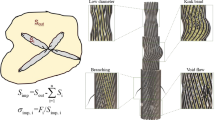Abstract
Applying transmission electron microscopy (TEM) on ultra-thin cross-sections of fibres, the main characteristics of the internal morphology of cotton and the main man-made cellulosic fibres (modal, viscose and lyocell) could be visualised. To obtain an appropriate contrast for TEM, isoprene was polymerised into the swollen fibres after a stepwise solvent exchange from water to acetone. The included polymer is stainable with osmium tetraoxide. Significant differences in distribution of pore sizes and pore arrangements in the cellulosic fibres were seen. Cotton showed very small pores in the bulk of the fibre, but drying cracks and flat pores between the sheets of the secondary wall appear as larger pores. Lyocell contains only nanopores in the bulk of the fibre with a slight gradient in pore density, and a very porous skin layer. In viscose and modal, a very wide pore size distribution from nanometer to micrometer size can be seen.
Similar content being viewed by others

References
Biganska O. 2002. Etude physico-chimique des solutions de cellulose dans la N-Methylmorpholine-N-Oxyde. Ph.D Thesis, Ecole Nationale des Mines de Paris, France
Bredereck K., Bühler A. (1992) Porenstrukturbestimmung von Cellulosefasern durch Ausschlußchromatographie. Grundlagen und Anwendungsbeispiele, für Quellbehandlungen und Hochveredlung von Baumwollgewebe. Melliand Textilberichte 73: 652–662
Bredereck K., Hermanutz F. (2005) Man-made cellulosics. Rev. Prog. Color 35: 59–75
Coulsey H.A., Smith S.B. (1995) The formation and structure of a new cellulosic fibre. Lenzinger Berichte 75: 51–61
Crawshaw J., Cameron R.E. (2000) A small angle X-ray scattering study of the pore structure in TENCEL® cellulose fibres and effects on physical treatments. Polymer 41: 4691
Crawshaw J., Vickers M.E., Briggs N.P., Heenan R.K., Cameron R.E. (2000) The hydration of TENCEL® cellulose fibres studied using contrast variation in small angle neutron scattering. Polymer 41: 1873–1881
Ducos F., Schuster K.C., Biganska O. and Navard P., manuscript in preparation
Eichinger D., Lotz C. (1996) Lenzing lyocell – potential for technical textiles. Lenzinger Berichte 75: 69–72
Fink H.P., Ganster J. 1994. Relations between structure and mechanical properties of cellulosic man-made fibres, Viscose Chemistry seminar proceedings, Stockholm, Sweden
Fink H.P., Weigel P., Ganster J., Rihm R., Puls J., Sixta H., Parajo J.C. (2004) Evaluation of new organosolv dissolving pulps. Part II: Structure and NMMO processability of pulps. Cellulose 11: 85–98
Hagege R., Kassenbeck P., Meimoun D., Parisot A. (1969) Electron microscopy of cellulosic structures by inclusion of stainable unsaturated polymers. Textile Res. J. 39: 1015–1022
Hearle J.W.S. (1958) Fringed-fibril theory of structure in crystalline polymers. J. Polymer Science 28: 432–435
Kongdee A., Bechtold T., Burtscher E., Scheinecker M. (2004) The influence of wet/dry treatment on pore structure – The correlation of pore parameters, water retention and moisture regain values. Carbohydr. Polym. 57: 39–44
Krässig H., Schrott E. (1945) Der Einfluss der Inclusion auf die Reaktivität unvernetzter und vernetzter Zellwolle. Makromol. Chem. 13: 179 – 193
Lenz J., Schurz J., Wrentschur E. (1993) Properties and structure of solvent-spun and viscose-type fibres in the swollen state. Colloid Polym. Sci. 271: 460–468
Mortimer S.A. 1995. Etude de la structure des fibres lyocell. Université Joseph Fourier – Grenoble I, Ph.D Thesis, France
Moss C.E., Butler M.F., Müller M., Cameron R.E. (2002) Microfocus small-angle X-ray scattering investigation of the skin-core microstructure of lyocell cellulose fibers. J. Appl. Polym. Sci. 83: 2799–2816
Purz H.J., Graf H., Fink H.P. (1995) Elektronenmikroskopische Untersuchungen zur Fibrillar- und Fällungsstruktur der Cellulose. Das Papier 12: 714 – 730
Reynolds E.S. (1963) The use of lead citrate at high pH as an electron opaque stain in electron microscopy. J. Cell Biol. 17: 208–212
Schurz J. (1994) What is new about new fibres of the lyocell type. Lenzinger Berichte 9/94: 37–40
Schuster K.C., Rohrer C., Eichinger D., Schmidtbauer J., Aldred P., Firgo H. (2003a) Environmentally friendly lyocell fibres. In: Wallenberger F.T., Weston N.E. (eds) Natural Fibres, Plastics and Composites. Kluwer Academic Publishers, Boston/Dordrecht/N.Y/London, pp. 123–146
Schuster K.C., Aldred P., Villa M., Baron M., Loidl R., Biganska O., Patlazhan S., Navarad P., Rüf H., Jericha E. (2003b) Characterising the emerging lyocell fibres structure by ultra small angle neutron scattering (USANS). Lenzinger Berichte 82: 107–117
Süvern K. (1921) Die Künstliche Seide. Springer-Berlin, Berlin, pp. 644
Zhang J., Zhu H., Shi K., Lai K. (1999) Study of the skin-core structure of lyocell staple fibres. Chem. Fibres Int. 49: 497–500
Acknowledgments
Thanks to Dr. S. Knaus, Vienna University of Technology, for facilitating the isoprene treatment of fibres for TEM preparation. Prof. T. Bechtold’s support as the head of the Christian Doppler Laboratory of Textile and Fibre Chemistry in Cellulosics, Dornbirn, Austria, is acknowledged. This work was in part financially supported by the Christian Doppler Research Society, Vienna, Austria.
Author information
Authors and Affiliations
Corresponding author
Rights and permissions
About this article
Cite this article
Rous, M.A., Ingolic, E. & Schuster, K.C. Visualisation of the fibrillar and pore morphology of cellulosic fibres applying transmission electron microscopy. Cellulose 13, 411–419 (2006). https://doi.org/10.1007/s10570-006-9052-5
Received:
Accepted:
Published:
Issue Date:
DOI: https://doi.org/10.1007/s10570-006-9052-5



